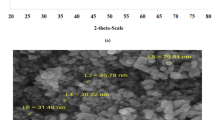Abstract
In this study, novel magnetic molecularly imprinted polymers (MMIPs) were developed as a sorbent for solid-phase extraction (SPE) and used for the selective separation of metronidazole (MNZ) in cosmetics; MNZ was detected by high-performance liquid chromatography (HPLC). First, magnetic Fe3O4 nanoparticles (NPs) were prepared by the co-precipitation of Fe2+and Fe3+ ions in an ammonia solution; then oleic acid (OA) was modified onto the surface of Fe3O4NPs. Finally, the MMIP was prepared by aqueous suspension polymerization, involving the copolymerization of Fe3O4NPs@OA with MNZ as the template molecule, methacrylic acid (MAA) as the functional monomer, ethylene glycol maleic rosinate acrylate (EGMRA) as the cross-linking agent, and 2,2-azobisisobutyronitrile (AIBN) as the initiator. The MMIP materials showed high selective adsorption capacity and fast binding kinetics for MNZ; the maximum adsorption amount of the MMIP to MNZ was 46.7 mg/g. The assay showed a linear range from 0.1 to 20.0 μg/mL for MNZ with the correlation coefficient 0.999. The relative standard deviations (RSD) of intra- and inter-day ranging from 0.71 to 2.45 % and from 1.06 to 5.20 % were obtained. The MMIP can be applied to the enrichment and determination of MNZ in cosmetic products with the recoveries of spiked toner, powder, and cream cosmetic samples ranging from 90.6 to 104.2, 84.1 to 91.4, and 90.3 to 100.4 %, respectively, and the RSD was <3.54 %.



Similar content being viewed by others

References
Ministry of Health of China (2007) Hygienic standard for cosmetics. Ministry of Health of the people’s Republic of China, Beijing
Llompart M, Celeiro M, Lamas JP, Sanchez-Prado L, Lores M, Garcia-Jares C (2013) Analysis of plasticizers and synthetic musks in cosmetic and personal care products by matrix solid-phase dispersion gas chromatography–mass spectrometry. J Chromatogr A 1293:10–19
Suyagh MF, Iheagwaram G, Kole PL, Millership J, Collier P, Halliday H, McElnay JC (2010) Development and validation of a dried blood spot–HPLC assay for the determination of metronidazole in neonatal whole blood samples. Anal Bioanal Chem 397:687–693
Beltrann A, Borrull F, Cormack PAG, Marce RM (2010) Molecularly-imprinted polymers: useful sorbents for selective extractions. Trends Anal Chem 29:1363–1375
Gao RX, Mu XR, Hao Y, Zhang LL, Zhang JJ, Tang YH (2014) Combination of surface imprinting and immobilized template techniques for preparation of core–shell molecularly imprinted polymers based on directly amino-modified F3O4 nanoparticles for specific recognition of bovine hemoglobin. J Mater Chem B 2:1733–1741
Li PF, Wang T, Lei FH, Tang PP, Tan XC, Liu ZG, Shen LQ (2014) Rosin-based molecularly imprinted polymers as the stationary phase in high-performance liquid chromatography for selective separation of berberine hydrochloride. Polym Int. doi:10.1002/pi.4694
Li XY, Li M, Lin JJ, Lei FH, Su XM, Liu M, Li PF, Tan XC (2014) Synthesis and characterization of molecularly imprinted polymers with modified rosin as a cross-linker and selective SPE-HPLC detection of basic orange II in foods. Anal Methods 6:6397–6406
Gao RX, Kong X, Su FH, He XW, Chen LX, Zhang YK (2010) Synthesis and evaluation of molecularly imprinted core–shell carbon nanotubes for the determination of triclosan in environmental water samples. J Chromatogr A 1217:8095–8102
Kong X, Gao RX, He XW, Chen LX, Zhang YK (2012) Synthesis and characterization of the core–shell magnetic molecularly imprinted polymers (F3O4@MIPs) adsorbents for effective extraction and determination of sulfonamides in the poultry feed. J Chromatogr A 1245:8–16
Yan HY, Wang F, Wang H, Yang GL (2012) Miniaturized molecularly imprinted matrix solid-phase dispersion coupled with high performance liquid chromatography for rapid determination of auxins in orange samples. J Chromatogr A 1256:1–8
Acknowledgments
This work was supported by the National Natural Science Foundation of China (No. 21165003, 31360162, and 21365004).
Conflict of interest
The authors declare that they have no conflict of interest.
Author information
Authors and Affiliations
Corresponding author
Rights and permissions
About this article
Cite this article
Liu, M., Li, XY., Li, JJ. et al. Synthesis of magnetic molecularly imprinted polymers for the selective separation and determination of metronidazole in cosmetic samples. Anal Bioanal Chem 407, 3875–3880 (2015). https://doi.org/10.1007/s00216-015-8592-7
Received:
Revised:
Accepted:
Published:
Issue Date:
DOI: https://doi.org/10.1007/s00216-015-8592-7



